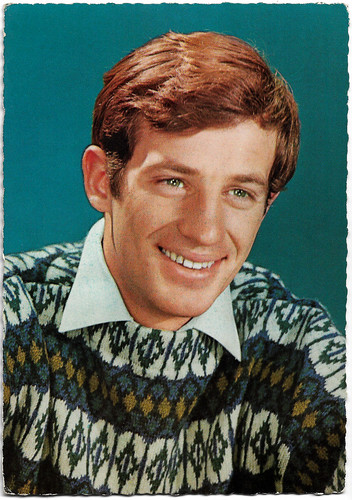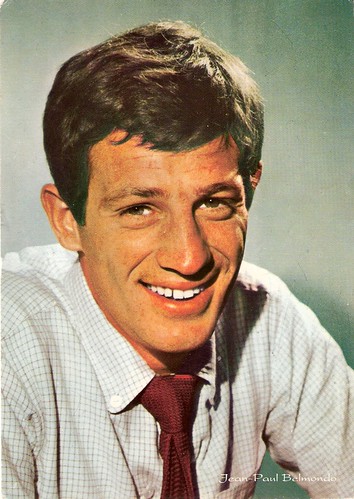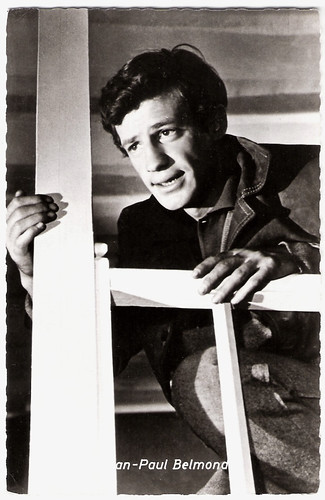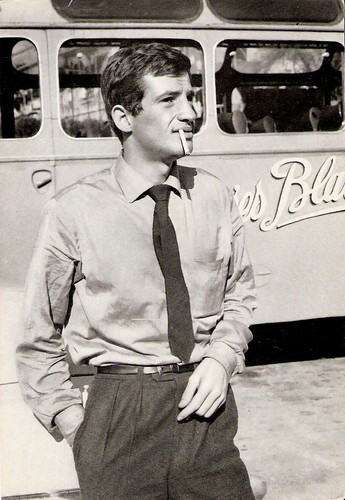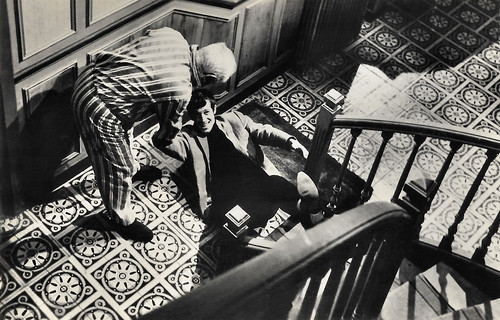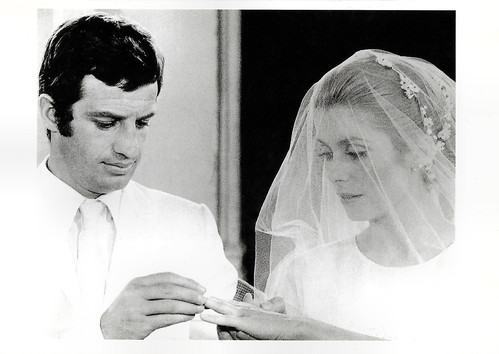
Dutch postcard by Gebr. Spanjerberg N.V., Rotterdam, no. 6100. Photo: Robert Lebeck / Combi Press, Amsterdam. Anna Karina and Jean-Luc Godard in Berlin, 1961. The couple was in Berlin for the presentation of Godard's third feature film Une femme est une femme/A Woman Is a Woman (Jean-Luc Godard, 1961) at the 11th Berlin International Film Festival. For her role in this film, Karina won the festival's Silver Bear award for Best Actress.
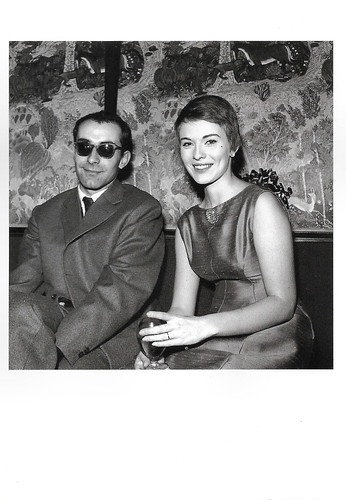
French postcard by Éditions Hazan, Paris, 1996. Photo: Raymond Depardon / Magnum. Caption: Jean Seberg and Jean-Luc Godard after the shooting of À bout de souffle.
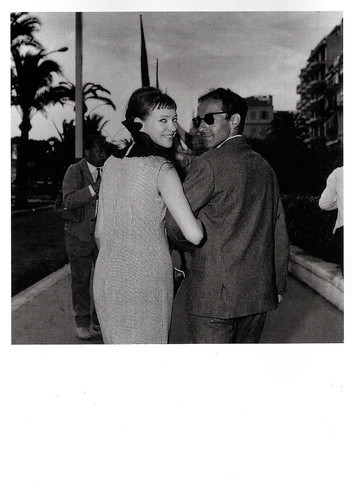
French postcard by Editions Cahiers du Cinéma, Paris, 1997. Photo: Traverso. Caption: Anna Karina and Jean-Luc Godard, Festival de Cannes 1963.

French postcard in the Collection Magie Noire by Éditions Hazan, Paris, 1994, no. 6430. Photo: Bruno Barbey / Magnum Photos. Jean-Luc Godard, Jean-Paul Sartre and Simone de Beauvoir, 1970.

French postcard by La Cinémathèque française. Photo: Georges Pierre. Caption: Jean-Luc Godard, photo of the shooting of Pierrot le Fou, 1965.
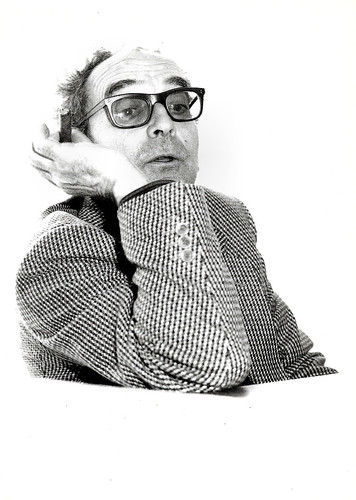
French postcard in the Collection Magie Noire by Éditions Hazan, Paris, 1988, no. 6077. Photo: Pierre-Olivier Deschamps / Agence Vu, Paris. Caption: Jean-Luc Godard, Mai 86.
Breaking with many then prevailing conventions
Jean-Luc Godard was born in Paris in 1930. His father was a doctor who owned a private clinic, and his mother came from a preeminent family of Swiss bankers. The family returned to Switzerland during World War II.
In 1949 he started studying ethnology at the Sorbonne. During this period he got to know François Truffaut, Jacques Rivette and Éric Rohmer. In 1950 he started a film newspaper 'Gazette du cinéma' with Rivette and Rohmer and collaborated on their films. In January 1952 he started writing for the film magazine 'Les Cahiers du cinéma', which had been founded the year before by André Bazin.
In 1953 he worked as a construction worker at a dam in Switzerland. With the money he earned, he made his first film, Opération Béton/Operation Concrete, a short documentary film about the construction of the dam. In 1956 he returned to France and resumed his work at Cahiers. During that time he made several short comedies and tributes to Mack Sennett and Jean Cocteau.
In 1959 he directed his first feature film, À bout de souffle/Breathless (1960), based on a screenplay by François Truffaut. This film played a key role in the birth of the Nouvelle Vague. It broke with many then prevailing conventions, with its references, influences from the American (gangster) film, the low budget, and the rough editing.
Jean-Paul Belmondo and Jean Seberg starred and the film was a huge success with audiences and critics. Godard won the Silver Bear for this film at the Berlin Film Festival 1960. Jean Seberg was nominated for a BAFTA Award. That year Godard also married Anna Karina, who would appear in many of his films. In 1964 they formed a production company, Anouchka Films. They divorced in 1965.

French postcard in the Collection Cinéma series by Editions Art & Scène, Paris, no. CF 29, 1995. Photo: Raymond Cauchetier, 1959. Jean-Paul Belmondo and Jean Seberg in A bout de souffle/Breathless (Jean-Luc Godard, 1960).

French postcard in the Collection Cinéma series by Editions Art & Scene, Paris, no. CF 83, 1995. Photo: Raymond Cauchetier, 1959. Jean-Paul Belmondo in A bout de souffle/Breathless (Jean-Luc Godard, 1960). In the background: the French poster for the American film Ten Seconds to Hell (Robert Aldrich, 1959). The caption translates as 'Right up close to Satan' comes very close.

French postcard by Editions Art & Scene, no. CF 98, 1996. Photo: R. Cauchetier. Jean-Paul Belmondo and Jean Seberg in A bout de souffle/Breathless (Jean-Luc Godard, 1960).

French postcard by Éditions Art & Scène, no. CF 107, 1996. Photo: R. Cauchetier. Jean Seberg in À bout de souffle/Breathless (Jean-Luc Godard, 1960).

British postcard by Pyramid, Leicester. French poster for À bout de souffle/Breathless (Jean-Luc Godard, 1960).
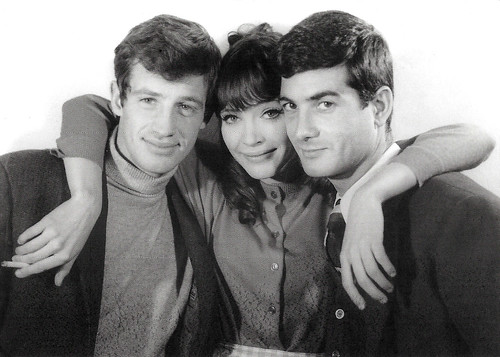
French postcard in the Collection Cinéma by Editions Art & Scene, Paris, no. CF 102, 1996. Photo: R. Cauchetier. Jean-Paul Belmondo, Anna Karina and Jean-Claude Brialy in Une femme est une femme/A Woman Is a Woman (Jean-Luc Godard, 1961).
Making political films political
In 1961 Jean-Luc Godard made his first colour film, the comedy Une femme est une femme/A Woman Is a Woman (1961) starring Anna Karina, Jean-Claude Brialy, and Jean-Paul Belmondo. It is a tribute to American musical comedy, filmed in cinemascope. Godard proved to be very productive during those years.
His first flop, the war film Les Carabiniers/The Carabineers (1963), was a tribute to Jean Vigo. That year he also made one of his greatest successes, Le Mépris/Contempt (1963) with Brigitte Bardot, Michel Piccoli, Jack Palance, and Fritz Lang.
Then followed Bande à part/Band of Outsiders (1964) with Anna Karina and Samy Frey, Pierrot le fou/Crazy Pierrot (1965) with Jean-Paul Belmondo and Anna Karina, and the Science-Fiction film Alphaville/Alphaville: A Strange Adventure of Lemmy Caution (1965) with Eddie Constantine. The film won the Golden Bear award of the 15th Berlin International Film Festival in 1965. Other films from those years were Masculin, feminin (1966) with Jean-Pierre Léaud, and Week-end (1967) with Mireille Darc.
Around the student uprisings of 1968, Godard became interested in Maoism. At that time he started an experimental political phase, which lasted until 1980. In the summer of 1968, together with Jean-Pierre Gorin, among others, he founded the Dziga Vertov Group, which wanted to make "political films political".
Some films from that time are Le Gai Savoir (1968), Pravda and One Plus One/Sympathy for the Devil (1968), the latter of which includes a unique recording of the studio build-up by the Rolling Stones of the classic 'Sympathy for the Devil'. In 1972 he made Tout va bien (1972), with Jane Fonda and Yves Montand in the lead roles, followed by Letter to Jane, a film about a photograph of Jane Fonda, which Gorin and Godard discuss. In 1972 he also met Anne-Marie Miéville, his later wife, with whom he made many films. This phase ended in 1980.

Dutch postcard by Hafbo film, no. 162. Anna Karina in Une femme est une femme/A Woman Is a Woman (Jean-Luc Godard, 1961).

French postcard. French poster for Vivre sa vie/My Life to Live (Jean-Luc Godard, 1962).

French postcard in the Collection Cinéma series by Editions Art & Scène, Paris, no. CF 101, 1996. Brigitte Bardot and Michel Piccoli in Le Mépris(Jean-Luc Godard, 1963).
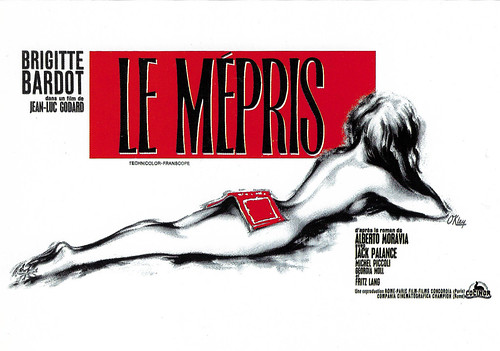
French postcard by BS, no. 31, 2005. French poster for Le Mépris (Jean-Luc Godard, 1963) starring Brigitte Bardot. Poster design: Pierre Okley, 1963.
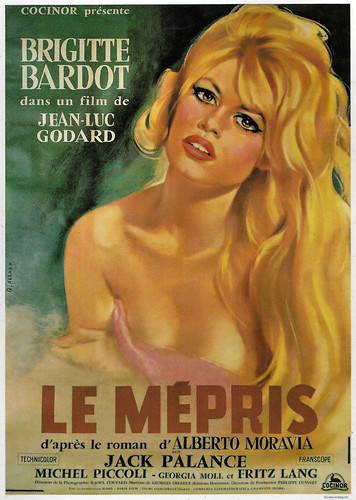
French postcard, no. 5979. Reproduction of French poster for Le Mépris/Contempt (Jean-Luc Godard, 1963) starring Brigitte Bardot. Poster design: G. Allard.

French postcard in the Collection Cinémathèque Suisse by CVB Publishers. French poster for Une femme mariée/A Married Woman (Jean-Luc Godard, 1964).

French postcard by La Cinémathèque Française. Photos: DR / Georges Pierre. Jean-Luc Godard, Jean-Paul Belmondo and Anna Karina during the shooting of Pierrot le Fou (Jean-Luc Godard, 1965).

French postcard by La Cinémathèque française, no. CF 5006, 1998. Photo: UGC Da International. Anna Karina and Jean-Paul Belmondo in Pierrot le fou (Jean-Luc Godard, 1965).
Dismissed as blasphemy by the Catholic Church
After twelve years of low budget, militant left-wing, and otherwise experimental film and video projects outside of commercial distribution, Jean-Luc Godard's first film that was more mainstream and accessible again was the drama Sauve qui peut (la vie)/Every Man for Himself (1980) with Isabelle Huppert, Jacques Dutronc, and Nathalie Baye.
His films after that time are more autobiographical. For example, in Sauve qui peut (la vie)/Every Man for Himself there was a character named Godard. In 1982 and 1983 he made three related films Passion (1982), Prénom Carmen (1983) and Je vous salue, Marie (1984). The latter film was dismissed as blasphemy by the Catholic Church.
The film King Lear (1987), which he made with Norman Mailer, also caused controversy. It was a bizarre postmodern take on the Shakespeare play, with theatre director Peter Sellars as a descendant of Shakespeare, Burgess Meredith as the mobster Don Learo, Jean-Luc Godard as the professor, and Woody Allen as a character called Mr. Alien. Not entirely coincidentally, Mr. Alien was also nicknamed Jean-Luc Godard.
From 1989 to 1998, he made the series Histoire(s) du Cinéma, about the twentieth century and the history of film. His most recent film was the avantgarde essay Le Livre d'image/The Image Book (2018).
Jean-Luc Godard passed away in 2022 in Rolle, Switzerland. He was 91.
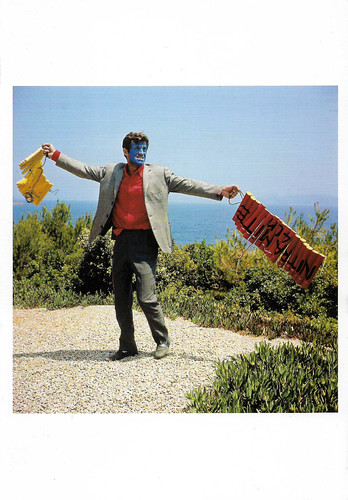
French postcard by La Cinémathèque française. Photo: Georges Pierre. Jean-Paul Belmondo in Pierrot le Fou (Jean-Luc Godard, 1965).

French postcard in the Collection Cinémathèque Suisse by CVB Publishers. French poster for Pierrot le fou/Pierrot Goes Wild (Jean-Luc Godard, 1965).

French postcard by Editions Le Malibran, Saint-Dié, no. CF 30. Photo: Georges Pierre. Anna Karina in Alphaville (Jean-Luc Godard, 1965). Photography: Raoul Coutard.
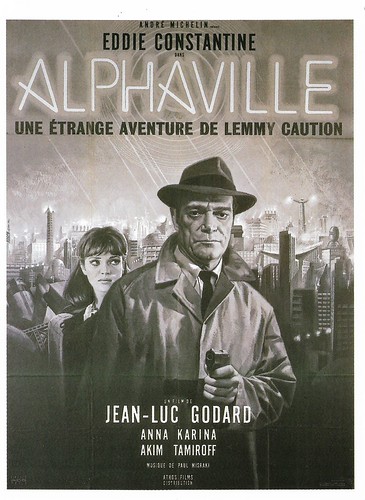
French postcard in the Collection Cinémathèque Suisse by CVB Publishers. French poster for Alphaville: une étrange aventure de Lemmy Caution/Alphaville: A Strange Adventure of Lemmy Caution (Jean-Luc Godard, 1965).

Swiss postcard by CVB Publishers / News Productions, no. 56935. Photo: Collection Cinémathèque Suisse. Reproduction of French poster for Masculin féminin (Jean-Luc Godard, 1966). Caption: the sex and youth of today's France.

French postcard in the Collection Cinémathèque Suisse by CVB Publishers. French poster for Deux ou trois choses que je sais d'elle/Two or Three Things I Know About Her (Jean-Luc Godard, 1967).

Swiss postcard by CVB Publishers, no. 56936. Photo: Collection Cinémathèque Suisse. Reproduction of Franco-Italian poster for Week-end (Jean-Luc Godard, 1967).

Swiss postcard by CVB Publishers. no. 57132. Photo: Collection Cinémathèque Suisse. Reproduction of French poster for Tout va bien/Just Great (Jean-Luc Godard, Jean-Pierre Gorin, 1972).

Vintage postcard by News Productions, Baulmes & Stroud / Filmwelt, Berlin, no. 56528. Photo: Collection Cinémathéque Suisse, Lausanne. Anna Baldaccini and Isabelle Huppert in Sauve qui peut (la vie)/Every Man for Himself (Jean-Luc Godard, 1980).

French postcard by La Cinémathèque française, no. CF 5009, 1998. Photo: UGC DA International. Jean-Paul Belmondo and Jean Seberg in A bout de souffle/Breathless (Jean-Luc Godard, 1960).
Sources: Wikipedia (Dutch and English), and IMDb.
